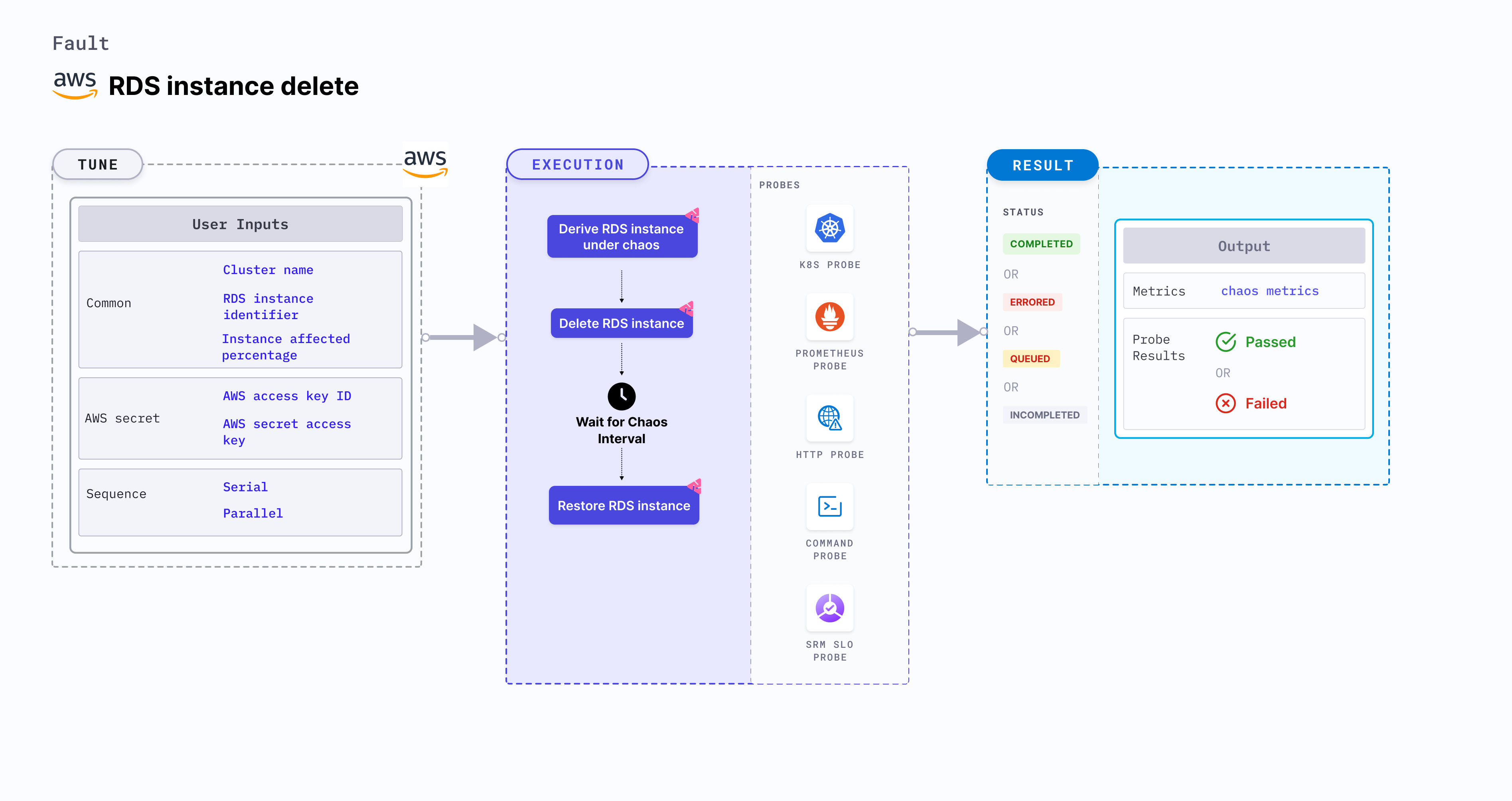RDS instance delete
RDS instance delete removes an instances from AWS RDS cluster. This makes the cluster unavailable for a specific duration.

Use cases
RDS instance delete determines how quickly an application can recover from an unexpected RDS cluster deletion.
Prerequisites
- Kubernetes >= 1.17
- AWS access to delete RDS instances.
- The RDS instance must be in a healthy state.
- Kubernetes secret must have the AWS access configuration(key) in the
CHAOS_NAMESPACE. A sample secret file looks like:apiVersion: v1
kind: Secret
metadata:
name: cloud-secret
type: Opaque
stringData:
cloud_config.yml: |-
# Add the cloud AWS credentials respectively
[default]
aws_access_key_id = XXXXXXXXXXXXXXXXXXX
aws_secret_access_key = XXXXXXXXXXXXXXX
HCE recommends that you use the same secret name, that is, cloud-secret. Otherwise, you will need to update the AWS_SHARED_CREDENTIALS_FILE environment variable in the fault template with the new secret name and you won't be able to use the default health check probes.
Below is an example AWS policy to execute the fault.
{
"Version": "2012-10-17",
"Statement": [
{
"Effect": "Allow",
"Action": [
"ec2:DescribeInstanceStatus",
"ec2:DescribeInstances",
"rds:DescribeDBClusters",
"rds:DescribeDBInstances",
"rds:DeleteDBInstance"
],
"Resource": "*"
}
]
}
- Go to superset permission/policy to execute all AWS faults.
- Go to the common tunables and AWS-specific tunables to tune the common tunables for all faults and AWS-specific tunables.
- Go to AWS named profile for chaos to use a different profile for AWS faults.
Mandatory tunables
| Tunable | Description | Notes |
|---|---|---|
| CLUSTER_NAME | Name of the target RDS cluster | For example, rds-cluster-1. For more information, go to RDS cluster name. |
| RDS_INSTANCE_IDENTIFIER | Name of the target RDS Instances | For example, rds-cluster-1-instance. For more information, go to RDS instance identifier. |
| REGION | The region name of the target RDS cluster | For example, us-east-1 |
Optional tunables
| Tunable | Description | Notes |
|---|---|---|
| TOTAL_CHAOS_DURATION | Duration that you specify, through which chaos is injected into the target resource (in seconds). | Default: 30 s. For more information, go to duration of the chaos. |
| INSTANCE_AFFECTED_PERC | The Percentage of total RDS instance that are part of RDS cluster to target | Default: 0 (corresponds to 1 instance). Provide numeric values only. |
| SEQUENCE | It defines sequence of chaos execution for multiple instance | Default: parallel. Supports serial and parallel. For more information, go to sequence of chaos execution. |
| AWS_SHARED_CREDENTIALS_FILE | Provide the path for AWS secret credentials | Default: /tmp/cloud_config.yml |
| RAMP_TIME | Period to wait before and after injection of chaos in sec | For example, 30 s. For more information, go to ramp time. |
RDS cluster name
Cluster name of the target RDS cluster. Tune it by using the CLUSTER_NAME environment variable. If this variable is not provided, the fault selects the Instance Identifier.
The following YAML snippet illustrates the use of this environment variable:
# delete the RDS instance
apiVersion: litmuschaos.io/v1alpha1
kind: ChaosEngine
metadata:
name: engine-nginx
spec:
engineState: "active"
annotationCheck: "false"
chaosServiceAccount: litmus-admin
experiments:
- name: rds-instance-delete
spec:
components:
env:
# provide the name of RDS cluster
- name: CLUSTER_NAME
value: 'rds-demo-cluster'
- name: REGION
value: 'us-east-2'
- name: TOTAL_CHAOS_DURATION
value: '60'
RDS instance identifier
RDS instance name. Tune it by using the RDS_INSTANCE_IDENTIFIER environment variable.
The following YAML snippet illustrates the use of this environment variable:
# delete the RDS instance
apiVersion: litmuschaos.io/v1alpha1
kind: ChaosEngine
metadata:
name: engine-nginx
spec:
engineState: "active"
annotationCheck: "false"
chaosServiceAccount: litmus-admin
experiments:
- name: rds-instance-delete
spec:
components:
env:
# provide the RDS instance identifier
- name: RDS_INSTANCE_IDENTIFIER
value: 'rds-demo-instance-1,rds-demo-instance-2'
- name: INSTANCE_AFFECTED_PERC
value: '100'
- name: REGION
value: 'us-east-2'
- name: TOTAL_CHAOS_DURATION
value: '60'